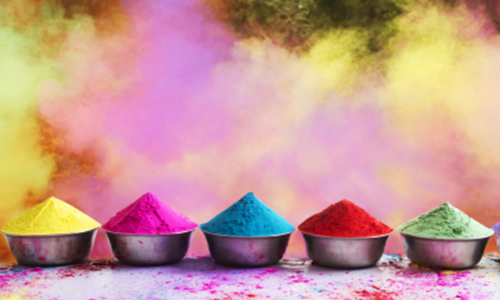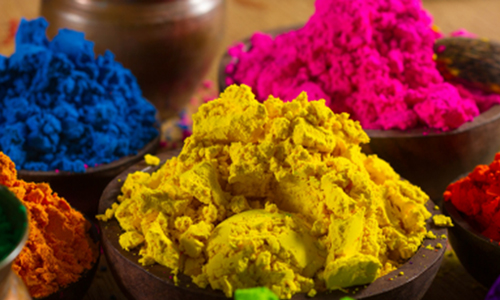The Holi festival is all about vibrant colors. There are, however, few risks that come with those beautiful splashing colors. Synthetic dyes used in the colors we buy in the market include dangerous compounds that may cause everything from allergies, itching, eye puffiness, and giddiness to significant health concerns, including blindness, renal failure, and cancer.
When we wash our hands after playing with these harmful colors, the chemicals in them enter the ecosystem, contaminating the soil and groundwater and destroying the natural habitat.
The most sustainable and eco-conscious thing you can do this Holi is to make these colours yourself at home. This way, you won’t have to worry about burning a hole in your pocket as well as maintain the health of your hair and skin and our ecosystem.

HOW TO MAKE YOUR OWN ORGANIC HOLI COLORS
Colours are the core of the Holi celebration, and if you don’t want to purchase them from the store because of the dangers of their chemical components, you only have one option: produce organic Holi colours at home using natural products.
You can produce gulal in a variety of colours at home, such as red, green, pink, blue, and yellow. We are here to help you guide how to create these colours at home.
RED
Allow Hibiscus or rose flowers to dry in the sun until the petals are crumbly and you can hear the crunchy sound. You may also combine the two flowers.
After the petals have dried, crush them in a blender until it results in a smooth powder.
To make this powder more aromatic, mix in a bowl of red sandalwood.
To make a concentrated solution, combine a teaspoon of limestone with a cup of water and a teaspoon of turmeric. Give it a good stir and use this mixture as a wet handmade red color after diluting it.
GREEN
Neem leaves can be dried until they are crumbly and crispy. In a blender, grind them until they’re a smooth powder, then add a pinch of sandalwood powder to make it scented.
Alternatively, some excellent quality henna powder can also be used as a natural green Holi color at home. Combine equal quantities of henna powder and wheat or plain flour in a mixing bowl. If you add a pinch of sandalwood powder to the mix, and you’re ready to go.
Simply combine henna powder and water until it results in a thick paste. You may also add a little oil for texture, and your green DIY Holi powder is complete.

YELLOW
In this condition, you can use turmeric (haldi) or gram flour (besan) directly to celebrate Holi, and they both will not harm your skin if you want to increase the quantity. Combine turmeric powder and gram flour (besan) in a 2:1 ratio. To generate a wet yellow hue, combine turmeric powder and gram flour (besan) in a 2:1 ratio with water.
Alternatively, you can boil marigold petals in water with a bit of turmeric to bring out the color even more.
BLUE
Neeli Gulmohar flower, which must be dry and powdered, is used to make natural blue color. To make it denser, add flour. To make the Holi color, mix cornstarch with blue food coloring in a basin.
PINK
Pink is one of the challenging natural colors to make due to only few options available for its ingredients. One of them is beetroot, which you can prepare by boiling beetroot in water (if this is your first time, start with a tiny batch). After some time, just use a grinder to ground it into a paste, then dry it in the sun for a while before mixing it with flour.
ORANGE
Take Tesu or Palash Tree flowers and dry them until they can be pulverized to produce an orange color powder. Toss in a pinch of flour into the food coloring.
Add some henna powder to a gallon of water and let it sit for a bit to generate an orange-colored liquid.
You may also get orange water by adding a few strands of Kesar(saffron) into boiling water.
BROWN
Take henna powder and amla powder and mix them. When you combine them, you’ll get a brown Holi color. To make brown water for a water gun, combine the same ingredients in water.
Mix brown food coloring with cornstarch in a basin. Use as much as you require.
PURPLE
To produce purple powder, combine a little maize powder with a few drops of purple food coloring.
Cut a few beetroots and boil them in water to get purple water. Allow it to cool before using it, or store it properly.

HAVE A SAFE AND HAPPY HOLI
There are certain safety recommendations for you to play a safe Holi, and if you’re a parent, it’s even better since you can teach your kids how to play a safe Holi without bothering anybody.
Start using environmentally friendly colors (chemical-free colors) To preserve your skin and face, apply oil to your entire body. Use as little water as possible.
Ensure that your hair has protection.
To keep your body hydrated, drink water every hour.
To protect your eyes, use sunglasses.
After the Holi celebration, take a quick bath with face wash or any other homemade cure.
To summarise, if you want to have a safe Holi causing no serious harm, all you have to do is manufacture organic Holi colors at home and start using them, as well as urging other people to use organic colors and follow the fantastic safety precautions we described above.




